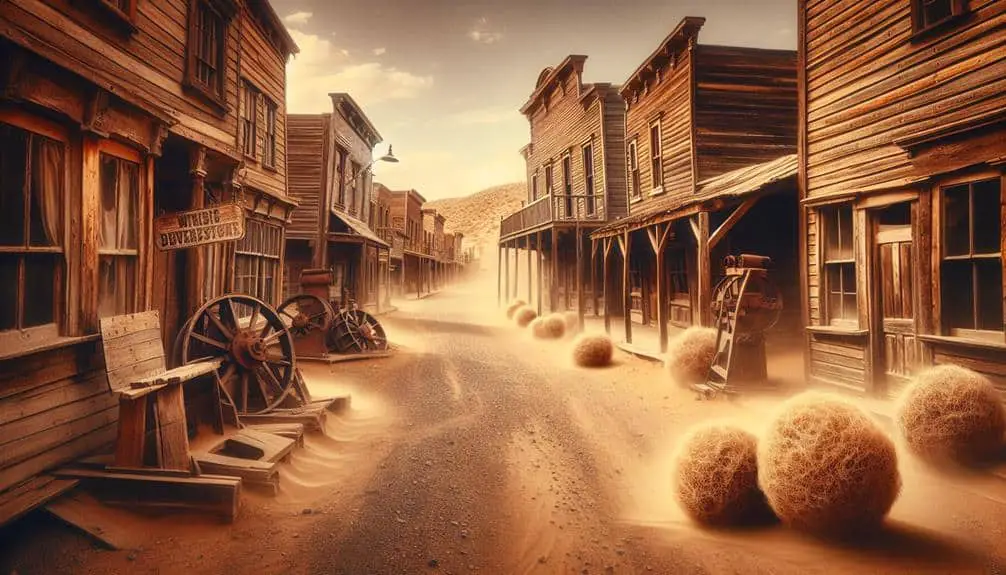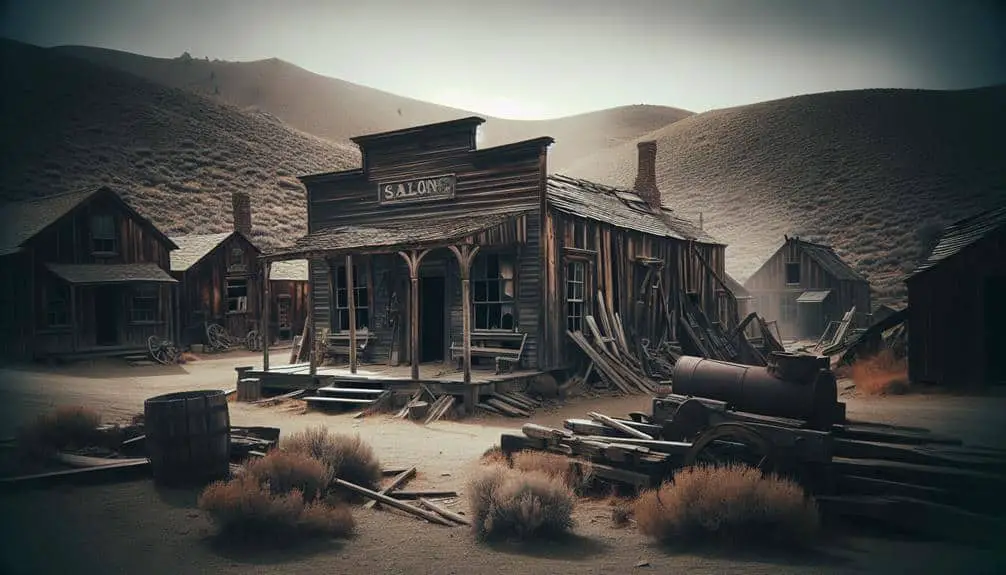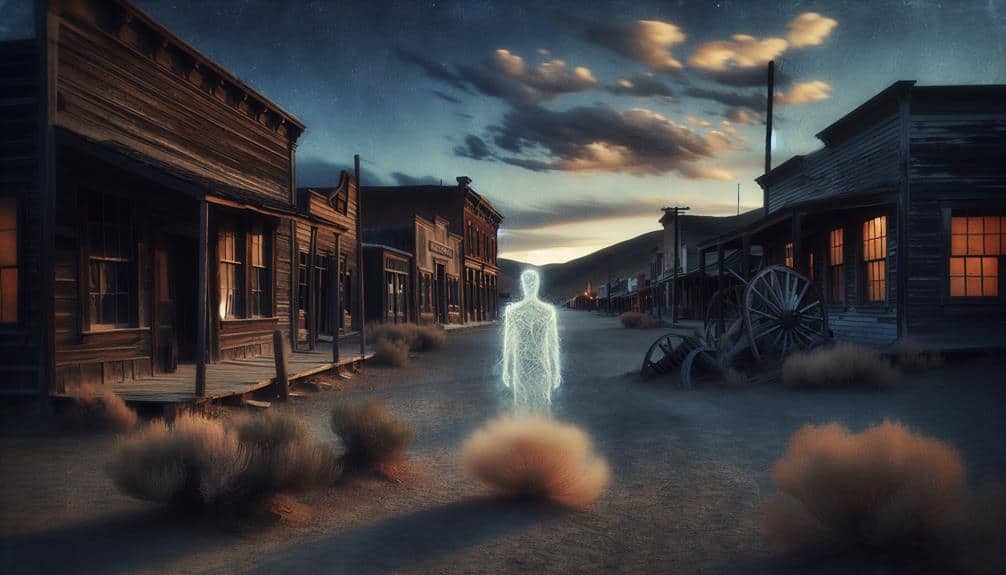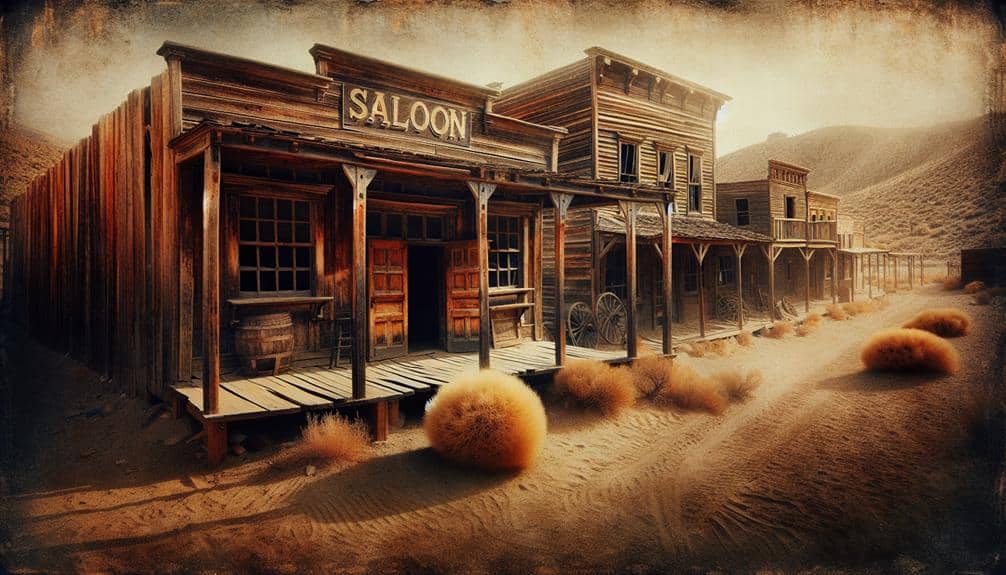Step into the past of Wild West mining towns to discover a complex history of gold rush boomtowns. Witness the stark economic disparities and environmental impact of mining. Explore the shift from bustling towns to eerie ghost towns as ore deposits depleted. Experience the lawlessness and vigilante justice that emerged to combat widespread crime. Learn about the revival of ghost towns through preservation efforts and economic revitalization. Uncover the enduring legacy of these towns as reflections of a bygone era and lessons for the future. Explore further to uncover the full tapestry of Wild West mining town history.
Key Points
- Environmental impact: deforestation, pollution, and scars on landscapes.
- Economic inequality: harsh conditions, meager pay for miners.
- Lawlessness: emergence of vigilante groups for maintaining order.
- Ghost town revival: historic preservation, economic revitalization through tourism.
- Enduring legacy: cultural preservation, economic impact, valuable lessons for future generations.
Gold Rush Boomtowns
During the Gold Rush era, bustling boomtowns emerged in the Wild West, driven by the allure of striking it rich through mining activities. The environmental impact of this rapid expansion was profound, with forests razed, rivers polluted, and landscapes scarred by mining operations. Sustainability was a foreign concept as the focus was on immediate gains rather than long-term consequences.
Economic inequality was stark in these boomtowns, with miners toiling in harsh conditions for meager pay while mine owners amassed vast fortunes. Labor rights were virtually non-existent, leading to exploitative practices and dangerous working environments. Workers often faced grueling hours, inadequate safety measures, and little job security.
Despite the hardships endured by many, the promise of gold continued to draw individuals from far and wide, fueling the growth of these boomtowns. The legacy of this era serves as a reminder of the need for balance between economic prosperity and social responsibility in the pursuit of wealth.
Boom to Bust: Mining Decline
The shift from bustling boomtowns to deserted ghost towns marked a significant turning point in the Wild West's mining history. As the once-lucrative mines started to deplete their rich ore deposits, the economic impact on these towns was profound. Businesses that relied on the mining industry began to struggle, leading to widespread unemployment and a rapid decline in population. This downturn not only affected the local communities but also reverberated throughout the region, causing a ripple effect on the economy as a whole.
Furthermore, the mining decline brought about severe environmental consequences. Abandoned mines posed significant risks to the surrounding ecosystems, contaminating water sources and endangering wildlife. The lack of proper regulations and oversight during the boom period left a legacy of environmental degradation that persisted long after the mines were abandoned. The scars of mining activity, such as deforestation, soil erosion, and polluted waterways, served as a stark reminder of the unsustainable practices that characterized the Wild West's mining era.
Lawlessness and Vigilantism
Amid the chaos and lawlessness that pervaded Wild West mining towns, vigilante groups emerged as a response to the lack of effective law enforcement. In these rugged frontier settlements, where outlaw gangs roamed freely, the concept of frontier justice took root, leading ordinary citizens to take matters into their own hands in the absence of a formal legal system.
- Vigilante Justice: Vigilante groups often operated outside the law, seeking to maintain order through swift and sometimes violent means.
- Community Support: These groups garnered support from the local community, who saw them as a necessary evil in the face of rampant crime.
- Swift Punishment: Vigilantes were known for delivering swift punishment to those deemed guilty, often resorting to methods considered extreme by today's standards.
- Legacy of Vigilantism: The legacy of vigilante justice in Wild West mining towns continues to spark debates on the thin line between upholding law and succumbing to lawlessness.
Ghost Towns Revival
As lawlessness subsided in some Wild West mining towns, a new phenomenon began to emerge – the revival of ghost towns. In an effort to preserve the historic essence of these once-booming settlements, individuals and communities turned their attention towards historic preservation. The dilapidated buildings and dusty streets that once echoed with the sounds of miners and traders were now seen as valuable relics of a bygone era, worthy of restoration and protection.
The revival of ghost towns also brought about economic revitalization to these areas. Entrepreneurs and investors recognized the potential for tourism and cultural interest in these abandoned sites. With careful planning and investment, these ghost towns were transformed into attractions that drew visitors from far and wide. From guided tours to themed events, these revitalized ghost towns became hubs of activity once again, albeit in a different form.
Through the combination of historic preservation and economic revitalization, these ghost towns found a new lease on life, serving as reminders of the Wild West's rugged past while embracing a sustainable future.
Legacy of Wild West Mining Towns
With the decline of Wild West mining towns, their heritage endures as evidence of the pioneering spirit and hardships of those who sought fortune in the rugged frontier. These towns, once bustling with activity, now stand as proof of a bygone era, offering a glimpse into a time of exploration and ambition. The legacy of Wild West mining towns resonates through the cultural preservation efforts and the lasting economic impact they've had on the regions they once thrived in.
- Cultural Preservation: Many of these mining towns have been preserved as historical sites, allowing visitors to immerse themselves in the rich tapestry of the Wild West era.
- Economic Impact: The legacy of Wild West mining towns continues to influence local economies, attracting tourists and historians alike, thereby contributing to the economic sustainability of these regions.
- Historical Significance: These towns serve as reminders of the challenges and triumphs of the past, offering valuable lessons for future generations.
- Community Engagement: Efforts to preserve the heritage of Wild West mining towns often involve local communities, fostering a sense of pride and connection to the area's history.
Frequently Asked Questions
What Were the Most Common Types of Businesses in Wild West Mining Towns Besides Saloons and Brothels?
Dig deep into the bustling Wild West mining towns, where besides saloons and brothels, you'd find essential businesses like general stores, blacksmiths crafting mining equipment, and mercantile shops. These were the lifeblood of the frontier community.
How Did Mining Towns Handle the Issue of Sanitation and Waste Management During the Gold Rush Era?
In the Wild West, mining towns coped with sanitation challenges by implementing rudimentary waste management systems. Sanitation practices included communal outhouses, waste pits, and occasional street cleaning. These measures aimed to control diseases and maintain basic hygiene standards.
Were There Any Notable Women or Minority Figures Who Played Significant Roles in the Development of Wild West Mining Towns?
Dig deep into the annals of Wild West mining towns, and you'll unearth a treasure trove of forgotten trailblazers. Women pioneers and minority entrepreneurs, against all odds, shaped these cultural melting pots into thriving communities.
What Were Some of the Lesser-Known Reasons for the Decline of Mining in Certain Towns?
You might not know, but environmental regulations, economic shifts, technological advancements, and labor disputes all played roles in the decline of mining towns. These factors affected the industry, leading to their eventual downfall.
How Did the Presence of Native American Tribes Impact the Development and Eventual Decline of Wild West Mining Towns?
Navigate the nuanced narratives of Native American relations and economic impact in Wild West mining towns. Cultural assimilation clashes and land disputes reveal the complex interplay shaping the development and decline of these communities.



